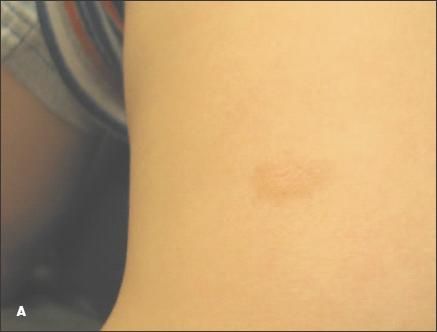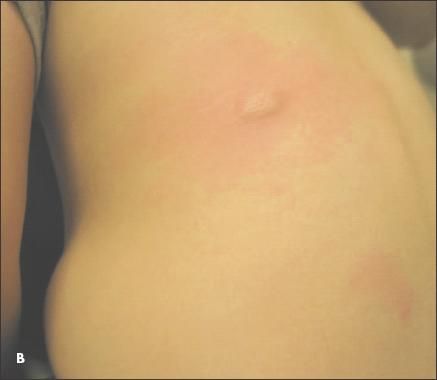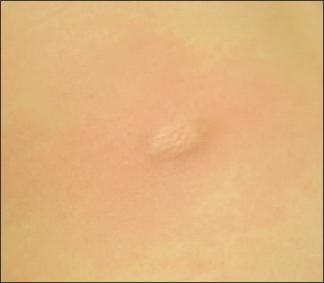Solitary Nodule With a Positive Darier Sign
Seventeen-month-old Hispanic boy with 7-month history of a swelling on his back. Lesion first looked like a small "scar," then gradually grew over next few months. Lesion appeared to blister, with subsequent discharge of clear fluid. No symptoms other than intermittent pruritus at lesion site. Patient not taking any medications.
HISTORY
Seventeen-month-old Hispanic boy with 7-month history of a swelling on his back. Lesion first looked like a small "scar," then gradually grew over next few months. Lesion appeared to blister, with subsequent discharge of clear fluid. No symptoms other than intermittent pruritus at lesion site. Patient not taking any medications.
Child born prematurely at 32 weeks' gestation with uncomplicated postnatal course. Several months before lesion appeared, another had been present on his cheek. Earlier lesion was excised: diagnosis was pilomatrixoma.
PHYSICAL EXAMINATION
Healthy-appearing child with normal growth and development. Small healed scar noted on the left cheek (site of pilomatrixoma).
The lesion on the back is a solitary tan-colored smooth-surfaced nodule of about 0.75 x 1.0 cm (A). No surrounding erythema or dyspigmentation.
Stroking of lesion with tongue blade causes wheal , followed by localized intense erythema (5 x 5 cm) (B) and discomfort. No flushing on cheeks or elsewhere.


WHAT'S YOUR DIAGNOSIS?
(Answer and discussion on next page.)
ANSWER: DARIER SIGN OF MASTOCYTOSIS
Darier sign (named after the French dermatologist who first described the phenomenon) describes the formation of a wheal or blister on stroking of a lesion. In its classic manifestation, gentle rubbing or stroking of a lesion is followed by local itching and erythema and wheal formation within 2 to 5 minutes. This process may persist from 30 minutes to several hours.1 The sign may be demonstrable on clinically normal skin in patients who have the more generalized form of mastocytosis. Some patients may also have systemic flushing and generalized pruritus.

A positive Darier sign establishes the diagnosis of mastocytosis. Stem cell factor (produced by keratinocytes) stimulates the proliferation of mast cells, which leads to release of both histamine and heparin. This factor also increases the production of melanin by melanocytes, which leads to eventual hyperpigmentation.2
The differential diagnosis of mastocytosis includes recurrent bullous impetigo, nevi, juvenile xanthogranuloma, and urticaria pigmentosa. Histopathological examination of the lesion site reveals monomorphic cuboid mast cells that infiltrate the upper dermis.
There are various presentations of cutaneous mastocytosis. The patient in this case has a solitary mastocytoma, which presents at birth or in early infancy and may occur in any area. Initially, it may appear as an evanescent wheal or blister. With time, an infiltrated tan, pink, or yellow, orange-peel macule, plaque, or nodule develops at the site of the wheal or blister. Hyperpigmentation surrounding the lesion may develop and become prominent. Rarely, systemic signs of histamine release occur at this time, and multiple lesions may develop.3
In a study of 55 patients with cutaneous mastocytosis, the most common presentation was involvement of trunk and extremities.4 Thirteen patients had a history of bullae; Darier sign was present in 34 of the 38 patients who were tested. Itching was the most common complaint, triggered by hot weather or hot baths.4
Mastocytomas tend to regress spontaneously.5 Avoidance of triggers-such as rubbing, trauma, heat, ingestion of alcohol or radiocontrast media, and physical exertion-is the main therapy. If the lesion is in an area of friction or is frequently symptomatic, topical corticosteroids can be applied to decrease the histamine reaction and pruritus. Surgical excision of solitary lesions is a possibility if the patient is symptomatic.
References:
REFERENCES:
1.
Surjushe A, Jindal S, Gote P, Saple DG. Darier's sign.
Indian J Dermatol Venereol Leprol.
2007;73:363-364.
2.
Valent P, Sperr WR, Schwartz LB, Horny HP. Diagnosis and classification of mast cell proliferative disorders: delineation from immunologic diseases and non-mast cell hematopoietic neoplasms.
J Allergy Clin Immunol.
2004;114:3-12.
3.
Valent P, Horny HP, Escribano L, et al. Diagnostic criteria and classification of mastocytosis: a consensus proposal.
Leuk Res.
2002;26:483-486.
4.
Akoglu G, Erkin G, Cakir B, et al. Cutaneous mastocytosis: demographic aspects and clinical features of 55 patients.
J Eur Acad Dermatol Venereol.
2006;20:969-973.
5.
Horny HP, Sotlar K, Valent P. Mastocytosis: state of the art.
Pathobiology.
2007;74:121-132.
Recognize & Refer: Hemangiomas in pediatrics
July 17th 2019Contemporary Pediatrics sits down exclusively with Sheila Fallon Friedlander, MD, a professor dermatology and pediatrics, to discuss the one key condition for which she believes community pediatricians should be especially aware-hemangiomas.